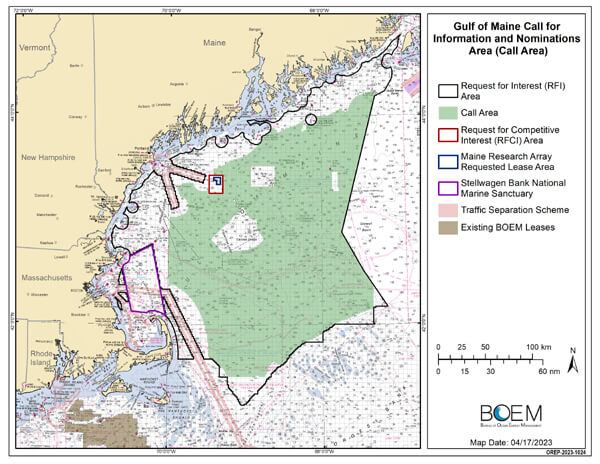BOEM Advances Offshore Wind Leasing Process in the Gulf of Maine

Efforts are proceeding in the process to open the Gulf of Maine as the next region in the United States for the offshore wind industry. The Bureau of Ocean Energy Management (BOEM) will publish a call for public input tomorrow, April 26, beginning a 45-day comment period as it continues to develop the plan for the region.
The Gulf of Maine spanning areas offshore of Massachusetts, New Hampshire, and Maine, is the final zone in the 2021 Offshore Wind Leasing Path Forward plan released by the bureau in 2021 as part of the government’s goal of deploying 30 gigawatts of offshore wind energy capacity by 2030. After opening the Gulf of Mexico for the first leases, BOEM’s plan proceeds to the Central Atlantic region followed by opening the Oregon coast for the first offshore wind projects. The plan anticipates that the Gulf of Maine would be designated as a Wind Energy Area in the middle of this year and the first lease sales could proceed in mid-2024.
The Gulf of Maine is considered to be one of the more challenging areas. It is exposed to stronger weather conditions and also has deeper conditions than the projects elsewhere on the U.S. East Coast. So far, the only development in the Gulf of Maine is a small, non-commercial site that is proceeding forward as a research location in efforts led by the University of Maine to develop floating wind turbine approaches. State officials have moved to block near-shore development due to concerns from the fishing and tourism industries, encouraging developers to focus on floating wind technology.

The Call Area is shown in green on the map (BOEM)
BOEM’s publication of its Gulf of Maine Call for Information and Nominations is the next step in the efforts to assess interest in possible commercial wind energy development in areas offshore Massachusetts, New Hampshire, and Maine. BOEM calls it an early step in the commercial planning and leasing process, and the first required by BOEM regulations.
“BOEM is committed to transparent, inclusive, and data-driven processes, and public input is essential to helping us determine areas that may be suitable for offshore wind development in the Gulf of Maine,” said BOEM Director Elizabeth Klein. “We are still early in the planning and leasing process, and we look forward to the multiple future opportunities for engagement.”
After the public comment period closes, BOEM will review and analyze commercial nominations and public comments submitted in response to the call. BOEM will also consider information from government and tribal consultations and the Gulf of Maine Intergovernmental Renewable Energy Task Force to further evaluate the appropriateness of the Call Area for offshore wind energy development.
The call follows the Department of the Interior’s August 2022 Request for Interest to gauge whether commercial interest existed in obtaining wind energy leases within an area in the Gulf of Maine comprising about 13.7 million acres. BOEM worked collaboratively with National Oceanic and Atmospheric Administration’s National Centers for Coastal Ocean Science (NCCOS) to conduct a spatial analysis of the area and considering feedback they note the final Call Area reduces the area to 9.8 million acres, a nearly 30 percent reduction. BOEM removed approximately 160,000 acres from future consideration to avoid Georges Bank.
BOEM has identified four areas that it is seeking public input on during this next phase of the review, including Lobster Management Area I, Platts Bank, Atlantic Large Whale Take Reduction Plan Restricted Areas, and Georges Bank (the immediately adjacent area along the southern boundary of the Call Area). They note that this is not an exhaustive list, but represents the areas that were most commented on in the most recent public engagement.
As part of the process, BOEM is also conducting task force meetings in Maine. The next one is scheduled for May 10-11, 2023, in Bangor, to update Task Force members and the public on BOEM’s commercial and research offshore wind energy planning activities and to discuss the next steps for the Gulf of Maine.
